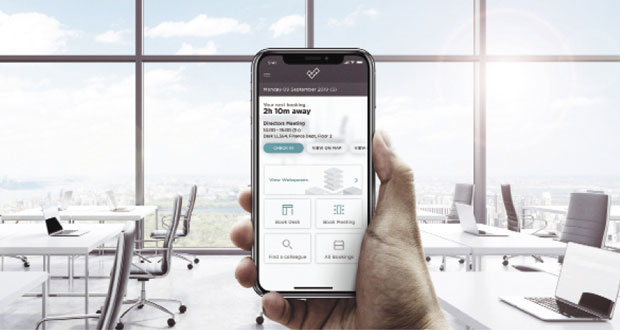JOHN GORMAN, MARKETING MANAGER SAMUEL BUTLER, CHANNEL ACCOUNT MANAGER ANDERS+KERN
The priorities for those working in FM have changed out of all recognition over the last six months. They’ve moved away from managing buildings and their occupants to juggling the needs of hybrid and office-based workers that are beginning to migrate back into the workplace. One the most important elements for CAFM developers is in talking to customers and finding out their needs, and for the foreseeable feature this means developing COVID-friendly software that helps FMs plan and organise buildings and occupancy as seamlessly as possible.
It is also important to offer customers as much flexibility as possible, which is why Space Connect software includes configuration rights, allowing users quick and easy access to manage their own system alternations without having to go back to the developer.
Desk booking
CAFM systems have had to adapt quickly to keep up over the last few months and for us the first realisation was that the demand for meeting room booking, which used to account for 80 to 90 per cent of enquires switched almost overnight to enquiries about desk booking.
Previously our desk booking software was used mainly to facilitate agile working practices, but in the age of COVID the idea of just turning up to choose a desk isn’t feasible. This is why users now have the option of choosing from bookable desks or fixed desks, the latter being for those who regularly need to be in the office and want an assigned place.
With social distancing being a priority, systems now offer managers access to floorplans and interactive maps that show which desks are available and blanks out those that need to be left free to assist social distancing. To avoid people wandering around the workplace, managers can also confirm via the dashboard assigned zones where particular teams can sit together. End users can access the desk booking via an app or online and – to ensure accountability they’ll be prompted by the system if they fail to register their arrival.
Cleaning and sanitisation is hugely important, and we are developing a tool that will give cleaning operatives access to a dedicated area of the system which will tell them which spaces need to be cleaned and enable them to sign off on areas that are ready for reoccupation. Managers can also add push notifications via the software to remind occupants to wash hands.
 Minimising contact is a crucial factor in the battle against infection, so meeting room software automatically integrates with Zoom, Teams and Skype to deliver touch free access to these platforms. By integrating the software with hardware (e.g. sensors, docking stations, facial recognition, contactless check-in, digital signage) FMs can install touch free systems at point of entries that enable visitors to use facial recognition to enter a building and notify the person they’re meeting to come and collect them, all without the need for any physical contact.
Minimising contact is a crucial factor in the battle against infection, so meeting room software automatically integrates with Zoom, Teams and Skype to deliver touch free access to these platforms. By integrating the software with hardware (e.g. sensors, docking stations, facial recognition, contactless check-in, digital signage) FMs can install touch free systems at point of entries that enable visitors to use facial recognition to enter a building and notify the person they’re meeting to come and collect them, all without the need for any physical contact.
Track and trace is a vital part of the battle against COVID, and the latest system enhancements allow the dashboard to track not only where an individual has been sitting in the workplace, but with a click of a button shows who else has sat in that spot to enable a fast response should it be needed.
Analytics
However, one of the most powerful benefits of the latest CAFM enhancements will be in utilising data and analytics to enable FMs to manage corporate real estate and assets.
One of the key ingredients for this is occupancy sensors, for instance positioned under or on desktops. Whereas in the past the use of sensors to measure occupancy levels was met with some reticence by clients who thought it very expensive and users who viewed it as a ‘big brother’ platform, the application of sensor integration into a CAFM system takes the product to a new level.
Using sensors, you can chart exactly how many people have utilised a particular area of a building, and for how long. That way, meeting rooms which are virtually redundant can be reappointed and office areas which may be utilised erratically can be addressed. The latest systems will even link to Bluetooth locations on a mobile app so the sensor will automatically know you were the person who booked the desk. The tech is expensive at the moment but the cost will go down as uptake increases.
The real power of the system will be when a real estate customer has for example, four offices and is able to use the data to work out how many desks are being booked, how much space is being used, how many meeting rooms are being utilised and how many ‘ghost bookings’ are being made.
But in the short-term for tackling COVID and the longer term in managing real estate and assets the latest CAFM systems are being honed to allow you to monitor not only the health of your occupants but the building.





